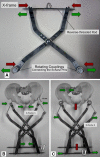Can a modified anterior external fixator provide posterior compression of AP compression type III pelvic injuries?
- PMID: 23604604
- PMCID: PMC3734429
- DOI: 10.1007/s11999-013-2993-8
Can a modified anterior external fixator provide posterior compression of AP compression type III pelvic injuries?
Abstract
Background: Current anterior fixators can close a disrupted anterior pelvic ring. However, these anterior constructs cannot create posterior compressive forces across the sacroiliac joint. We explored whether a modified fixator could create such forces.
Questions/purposes: We determined whether (1) an anterior external fixator with a second anterior articulation (X-frame) would provide posterior pelvic compression and (2) full pin insertion would deliver higher posterior compressive forces than half pin insertion.
Methods: We simulated AP compression Type III instability with plastic pelvis models and tested the following conditions: (1) single-pin supraacetabular external fixator (SAEF) using half pin insertion (60 mm); (2) SAEF using full pin insertion (120 mm); (3) modified fixator with X-frame using half pin insertion; (4) modified fixator using full pin insertion; and (5) C-clamp. Standardized fracture compression in the anterior and posterior compartment was performed as in previous studies by Gardner. A force-sensitive sensor was placed in the symphysis and posterior pelvic ring before fracture reduction and the fractures were reduced. The symphyseal and sacroiliac compression loads of each application were measured.
Results: The SAEF exerted mean compressions of 13 N and 14 N to the posterior pelvic ring using half and full pin insertions, respectively. The modified fixator had mean posterior compressions of 174 N and 222 N with half and full pin insertions, respectively. C-clamp application exerted a mean posterior load of 407 N.
Conclusions: Posterior compression on the pelvis was improved using an X-frame as an anterior fixation device in a synthetic pelvic fracture model.
Clinical relevance: This additive device may improve the initial anterior and posterior stability in the acute management of unstable and life-threatening pelvic ring injuries.
Figures


Similar articles
-
Simultaneous anterior and posterior compression of the pelvic ring with external fixation using a pre-tensed curved bar: A biomechanical study.Injury. 2013 Dec;44(12):1787-92. doi: 10.1016/j.injury.2013.08.016. Epub 2013 Aug 27. Injury. 2013. PMID: 24016457
-
Anterior internal fixator versus a femoral distractor and external fixation for sacroiliac joint compression and single stance gait testing: a mechanical study in synthetic bone.Int Orthop. 2013 Jul;37(7):1341-6. doi: 10.1007/s00264-013-1890-9. Epub 2013 May 4. Int Orthop. 2013. PMID: 23645004 Free PMC article.
-
Sacroiliac joint compression using an anterior pelvic compressor: a mechanical study in synthetic bone.J Orthop Trauma. 2007 Aug;21(7):435-41. doi: 10.1097/BOT.0b013e318126bb8e. J Orthop Trauma. 2007. PMID: 17762472
-
The Use of External Fixation for the Management of the Unstable Anterior Pelvic Ring.J Orthop Trauma. 2018 Sep;32 Suppl 6:S14-S17. doi: 10.1097/BOT.0000000000001251. J Orthop Trauma. 2018. PMID: 30095676 Review.
-
Fixation of Anterior Pelvic Ring Injuries.J Am Acad Orthop Surg. 2019 Sep 15;27(18):667-676. doi: 10.5435/JAAOS-D-17-00839. J Am Acad Orthop Surg. 2019. PMID: 30889037 Review.
Cited by
-
Effect of C-Clamp Application on Hemodynamic Instability in Polytrauma Victims with Pelvic Fracture.Medicina (Kaunas). 2022 Sep 16;58(9):1291. doi: 10.3390/medicina58091291. Medicina (Kaunas). 2022. PMID: 36143972 Free PMC article.
-
How effective are different models of pelvic binders: results of a study using a Pelvic Emergency Simulator.Eur J Trauma Emerg Surg. 2022 Apr;48(2):847-855. doi: 10.1007/s00068-020-01406-0. Epub 2020 May 26. Eur J Trauma Emerg Surg. 2022. PMID: 32458045
-
The role of anterior supra-acetabular external fixator as definitive treatment for anterior ring fixation in unstable pelvic fractures.Eur J Trauma Emerg Surg. 2022 Oct;48(5):3737-3746. doi: 10.1007/s00068-021-01711-2. Epub 2021 Jun 7. Eur J Trauma Emerg Surg. 2022. PMID: 34097076
-
A Method of Using a Pelvic C-Clamp for Intraoperative Reduction of a Zone 3 Sacral Fracture.Case Rep Orthop. 2016;2016:8586517. doi: 10.1155/2016/8586517. Epub 2016 Dec 22. Case Rep Orthop. 2016. PMID: 28101390 Free PMC article.
-
Pelvic ring injuries: Surgical management and long-term outcomes.J Clin Orthop Trauma. 2016 Jan-Mar;7(1):1-6. doi: 10.1016/j.jcot.2015.08.001. Epub 2015 Sep 2. J Clin Orthop Trauma. 2016. PMID: 26908968 Free PMC article. Review.
References
-
- Bassam D, Cephas GA, Ferguson KA, Beard LN, Young JS. A protocol for the initial management of unstable pelvic fractures. Am Surg. 1998;64:862–867. - PubMed
-
- Biffl WL, Smith WR, Moore EE, Gonzalez RJ, Morgan SJ, Hennessey T, Offner PJ, Ray CE, Jr, Franciose RJ, Burch JM. Evolution of a multidisciplinary clinical pathway for the management of unstable patients with pelvic fractures. Ann Surg. 2001;233:843–850. doi: 10.1097/00000658-200106000-00015. - DOI - PMC - PubMed
MeSH terms
LinkOut - more resources
Full Text Sources
Other Literature Sources
Medical

